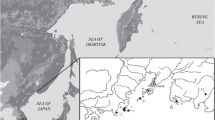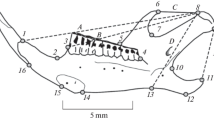Abstract—
Methods of geometric morphometrics have been used to study geographic and chronographic forms of variation in the shape of the upper third molar (M3) in the gray red-backed vole C. rufocanus, a petrophilic rodent specialized to mountain habitats in the Urals. It has been shown that sexual dimorphism in M3 shape increases in the direction from the Southern to the Polar Urals. In the Middle Urals, differences in M3 shape (more distinct in males than in females) have been revealed between samples taken in years of high and low abundance of the species, which are apparently conditioned by a switch in tooth morphogenesis. This is suggestive of change in the morphofunctional properties of teeth and in related trophic preferences of males and females, i.e., in the possibility for them to consume different spectra of food resources. The increase in M3 sexual dimorphism in the south–north direction and in low-mountain biotopes (not common for the species) is in agreement with Chernov’s compensation principle manifested at the intra- and interpopulation levels, as it helps to alleviate trophic competition between males and females. The phenotypic plasticity of teeth provides for population-cenotic stability of the species in climatically unfavorable years and in atypical biotopes and environmental conditions of the Polar Ural Mountains.






Similar content being viewed by others
REFERENCES
Pigliucci, M., Do we need an extended evolutionary synthesis?, Evolution, 2007, vol. 61, pp. 2743–2749.
Dickins, T. and Rahman, Q., The extended evolutionary synthesis and the role of soft inheritance in evolution, Proc. R. Soc. B, 2012, vol. 278, pp. 1721–1727.
Laland, K.N., Uller, T., Feldman, M.W., et al., The extended evolutionary synthesis: Its structure, assumptions and predictions, Philos. Trans. R. Soc. B.: Biol. Sci., 2015, vol. 282, pp. 1–14.
Jablonka, E. and Raz, G., Transgenerational epigenetic inheritance: prevalence, mechanisms, and implications for the study of heredity and evolution, Q. Rev. Biol., 2009, vol. 84, pp. 131–176.
Burggren, W., Epigenetic inheritance and its role in evolutionary biology: Re-evaluation and new perspectives, Biology, 2016, vol. 5, no. 24, pp. 2–22.
Vasil’ev, A.G., Evolutionary ecology in the 21st century: New concepts and development prospects, Russ. J. Ecol., 2019, vol. 50, no. 2, pp. 102–114.
Wagner, G.P. and Draghi, J., Evolution of evolvability, in Evolution: The Extended Synthesis, Pigliucci, M. and Müller, G.B., Eds., Cambridge, MA: MIT Press, 2010, pp. 218–228.
Schlichting, C.D. and Wund, M.A., Phenotypic plasticity and epigenetic marking: An assessment of evidence for genetic accommodation, Evolution, 2014, vol. 68, pp. 656–672.
Sterelny, K., What is evolvability?, in Philosophy of Biology, Matthen, M. and Stephens, C., Eds., Amsterdam: Elsevier, 2007, pp. 163–178.
Vasil’ev, A.G., Vasil’eva, I.A., and Shkurikhin, A.O., Geometricheskaya morfometriya: ot teorii k praktike (Geometric Morphometrics: From Theory to Practice), Moscow: KMK, 2018.
Berdyugin, K.I., Bol’shakov, V.N., Balakhonov, V.S., et al., Mlekopitayushchie Polyarnogo Urala (Mammals of the Polar Urals), Yekaterinburg: Ural. Gos. Univ., 2007.
Abramson, N.I., Petrova, T.P., Dokuchaev, N.E., et al., Phylogeography of the gray red-backed vole Craseomys rufocanus (Rodentia: Cricetidae) across the distribution range inferred from nonrecombining molecular markers, Russ. J. Theriol., 2012, vol. 11, no. 2, pp. 137–156.
Chernov, Yu.I., Species diversity and compensatory phenomena in communities an biotic systems, Zool. Zh., 2005, vol. 84, no. 10, pp. 1221–1238.
Vasil’ev, A.G., Vasil’eva, I.A., Gorodilova, Yu.V., and Dobrinskii, N.L., Chernov’s compensation principle and the effect of rodent community completeness on the variability of bank vole (Clethrionomys glareolus) population in the Middle Urals, Russ. J. Ecol., 2017, vol. 48, no. 2, pp. 161–169.
Vasil’ev, A.G., Bol’shakov, V.N., Evdokimov, N.G., and Sineva, N.V., Morphological diversity of mole vole mono- and polymorphic populations: Does Chernov’s “compensation principle” work within a population?, Dokl. Biol. Sci., 2016, vol. 468, pp. 118–121.
Vorontsov, N.N., The lower Cricetidae of the world fauna, part 1: Morphology and ecology, Fauna SSSR. Mlekopitayushchie (The Fauna of the Soviet Union), vol. 3, Leningrad: Nauka, 1982.
Bol'shakov, V.N., Vasil’eva, I.A., and Maleeva, A.G., Morfotipicheskaya izmenchivost' zubov polevok (Morphotypic Variability of Teeth in Voles), Moscow: Nauka, 1980.
Vasil’ev, A.G. and Vasil’eva, I.A., Gomologicheskaya izmenchivost’ morfologicheskikh struktur i epigeneticheskaya divergentsiya taksonov: Osnovy populyatsionnoi meronomii (Homological Variability of Morphological Structures and Epigenetic Divergence among Taxa: Principles of Population Meronomy), Moscow: KMK, 2009.
Pokrovskii, A.V. and Bol’shakov, V.N., Eksperimental’naya ekologiya polevok (Experimental Ecology of Voles), Moscow: Nauka, 1979.
Pavlinov, I.Ya. and Mikeshina, N.G., Principles and methods of geometric morphometrics, Zh. Obshch. Biol., 2002, vol. 63, no. 6, pp. 473–493.
Voyta, L.L., Golenishchev, F.N., and Tiunov, M.P., Analysis of shape and size variation of the first lower molar in the far-eastern grey voles of genus Alexandromys (Rodentia: Cricetidae) from Russian fauna using geometric morphometrics, Russ. J. Theriol., 2013, vol. 12, no. 1, pp. 19–32.
Sheets, H.D. and Zelditch, M.L., Studying ontogenetic trajectories using resampling methods and landmark data, Histrix, 2013, vol. 24, no. 1, pp. 67–73.
Rohlf, F.J. and Slice, D., Extension of the Procrustes method for the optimal superimposition of landmarks, Syst. Zool., 1990, vol. 39, no. 1, pp. 40–59.
Zelditch, M.L., Swiderski, D.L., Sheets, H.D., and Fink, W.L., Geometric Morphometrics for Biologists: A Primer, New York: Elsevier, 2004.
Klingenberg, C.P., MorphoJ: An integrated software package for geometric morphometrics, Mol. Ecol. Resour., 2011, vol. 11, pp. 353–357.
Rohlf, F.J., TpsUtil, Version 1.60, Department of Ecology and Evolution, State University of New York at Stony Brook, 2013.
Rohlf, F.J., TpsDig2: Digitize Landmarks and Outlines, Version 2.17, Department of Ecology and Evolution, State University of New York at Stony Brook, 2013.
Lovich, J.E. and Gibbons, J.W., A review of techniques for quantifying sexual size dimorphism, Growth Dev. Aging, 1992, vol. 56, pp. 269–281.
Davis, J.C., Statistics and Data Analysis in Geology, 2nd ed., New York: Wiley, 1986. Translated under the title Statisticheskii analiz dannykh v geologii, Moscow: Nedra, 1990, vol. 2.
Hammer, Ø., New methods for the statistical analysis of point alignments, Comput. Geosci., 2009, vol. 35, pp. 659–666.
Hammer, Ø., Harper, D.A.T., and Ryan, P.D., PAST: Paleontological statistics software package for education and data analysis, Palaeontol. Electron., 2001, vol. 4, no. 1.
Vasil’ev, A.G. and Lunev, A.V., Analysis of variation in the shape of M3 tooth in gray red-backed voles from the Visim Biosphere Reserve using the methods of geometric morphometrics, in Ekologicheskie issledovaniya v Visimskom biosfernom zapovednike: Mat-ly nauch. konf., posvyashch. 35-letiyu Visimskogo zapovednika (Ecological Studies in the Visim Biosphere Reserve: Proc. Sci. Conf. Dedicated to the 35th Anniversary of the Reserve), Yekaterinburg: Sredne-Ural. Knizhn. Izd., pp. 94–100.
Olenev, G.V., Population mechanisms of adaptation to extreme environmental factors: The example of bank vole, Zh. Obshch. Biol., 1981, no. 4, pp. 506–511.
Borodin, A.V. and Markova, E.A., Keys to identify modern and Pleistocene arvicolines (Arvicolinae, Rodentia) from the Urals and Western Siberia based on odontological characteristics, Biol. Bull. (Moscow), 2015, vol. 42, no. 7, pp. 652–663.
ACNOWLEDGMENTS
The authors are grateful to the Zoological Museum of the Institute of Plant and Animal Ecology (Ural Branch, Russian Academy of Sciences) and personally to Dr. K.I. Berdyugin for providing the opportunity to work with the craniological collections and to A.V. Lunev for preparing the series of digital images of M3 teeth.
Funding
This study was performed under the State Contract no. AAAA-A19-119031890087-7 of the Institute of Plant and Animal Ecology and supported by the Integrated Research Program of the Ural Branch, Russian Academy of Sciences (project no. 18-4-4-28).
Author information
Authors and Affiliations
Corresponding author
Additional information
Translated by N. Gorgolyuk
Rights and permissions
About this article
Cite this article
Vasil’ev, A.G., Bol’shakov, V.N. & Vasil’eva, I.A. Intra- and Interpopulation Odontological Variability in the Gray Red-backed Vole (Craseomys rufocanus) and Yu.I. Chernov’s Compensation Principle. Russ J Ecol 51, 1–10 (2020). https://doi.org/10.1134/S1067413620010130
Received:
Revised:
Accepted:
Published:
Issue Date:
DOI: https://doi.org/10.1134/S1067413620010130




